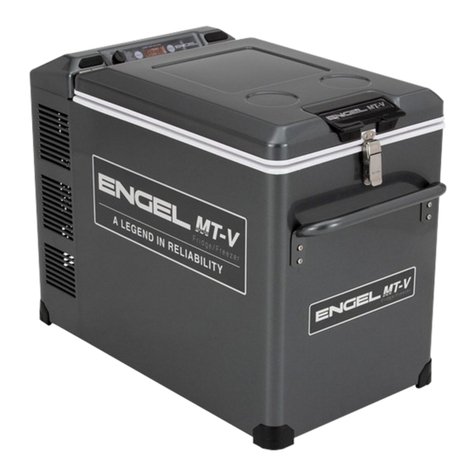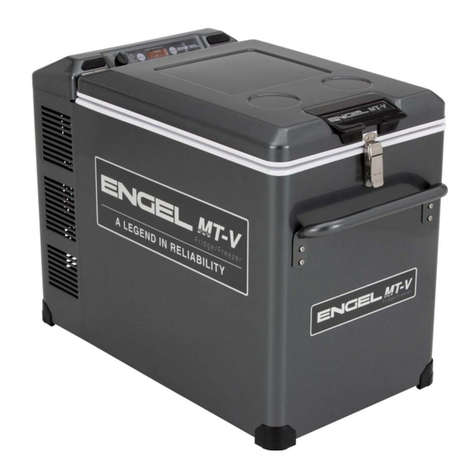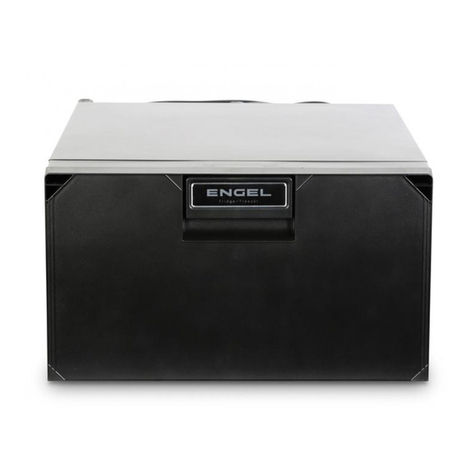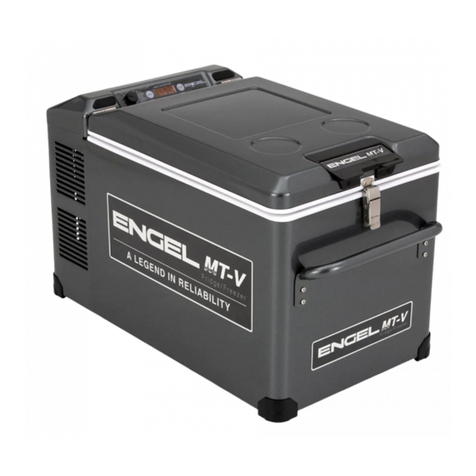
- 1 -
Thank you for purchasing an ENGEL refrigerator. Read this
manual carefully before starting to use it. Keep this manual in
a safe place for future reference. If the product is resold, this
operating manual must accompany it.
1 . Explanation of symbols
2 . Safety instructions
3 . Intended use
4 . Controller and display
5 . Installation and ventilation
6 . Operation
7 . Maintenance of refrigerator
8. Tilt protection
9. Trouble shooting
10. Disposal
11. Warranty
12. Before initial use
13. Technical data
〈APPENDIX〉
Service agent
6.1 Connection to 12V or 24V DC battery
6.1.1 Onboard direct wiring
6.1.2 Wiring diagram of dual battery hookup
7.1 Cleaning interior and door
7.2 Defrosting
12.1 Relocating the compressor unit
12.2 Direction of fan for free-standing
CONTENTS
........................................................... 2
................................................................... 2
.............................................................................9
...............................................................9
..................................................... 10
................................................................................ 12
.............................. 12
............................................. 12
.................. 14
.................................................... 15
............................................... 15
........................................................................ 15
.......................................................................... 16
..................................................................... 16
................................................................................ 17
................................................................................. 17
.................................................................... 18
.................................... 18
................................... 19
........................................................................ 20
............................................................................... 21
............................................................................... 25
• This refrigerator can be used by children age 8 and above
and persons with reduced physical, sensory or mental
capabilities or lack of experience and knowledge if they have
been given supervision or instruction concerning the use of
the refrigerator in a safe way and understand the hazards
involved.
• Children shall not play with the refrigerator. Always keep and
use the refrigerator out of the reach of children.
• Cleaning and user maintenance shall not be made by children
without supervision.
• Do not store explosive substances such as aerosol cans with
a flammable propellant in this refrigerator.
• Never expose the refrigerator to rain.
•Do not put a water-filled container. Water if spilled will degrade
the insulation of electric components and may lead to a fire
from electric leak.
• If the cable is damaged, it must be replaced to prevent the
possibility of electric shock. It must be replaced with a new
cord (ENGEL genuine products).
•Never disassemble the refrigerator by yourself. Inadequate
repairs may lead to considerable hazards.
• Do not touch the inside and other metal parts of the cabinet
with wet hands, as this may cause frostbite.
•Do not contact metal part with positive terminal of battery.
•Cyclopentane is used as in the insulation. The gases in
insulation material require a special disposal procedure with
theapplicable disposal regulations.
•Use the DC cord originally accompanying the refrigerator
when operating it on DC. Failing to do so may lead to a fire
due tooverheat.
•When replacing a fuse equipped inside the fuse holder of DC
cord, always use the same rated fuse for replacement. Never
use a wire or a lead instead. Doing so may lead to a firefrom
overheat.
•This refrigerator runs on DC such as battery. Do not attempt
to run it on any voltage above the specified voltage, nor use it
with any power source not specified here. Failing to comply
willresult in product failure or lead to a fire.
•Do not attempt to hang on the refrigerator door. Do not sit on
the refrigerator while the door is open. Doing so may lead to
injuries due to tumbled refrigerator or the fingers being caught
inthe door.
•Do not put heavy objects on the refrigerator. Doing so may
lead to injury from falling objects when the door opens.
•Be sure that no part of the refrigerator body is pushing its
powercable to bend it hard. The cable, when bent hard, may
getdamaged and lead to overheat and a fire.
• Avoid using flammable sprays near the refrigerator. The
electriccontacts may catch a fire.
•When using the refrigerator in a trunk of the car, keep
adequate ventilation. Failing to do so may overheat and
damage therefrigerator and possibly lead to a fire.
•Do not store objects that require precise temperature control
such as medicine and scientific specimens. This refrigerator is
not suited to store such types of objects.
• When there is a leak of utility gas around you, do not touch
the refrigerator or its cable plug. Open the windows and
maintain good ventilation. Failing to do so may lead to a fire
and/or a burn from explosion.
• When operating on a floor, securely fix the refrigerator so that
it would not fall and cause injuries when encountering
vibration such as earth quake.
• While the refrigerator is in operation, do not use a quick
charger to charge the battery that is supplying power to the
refrigerator. The high voltages generated from the charger
may damage the refrigerator and lead to a fire.
• Do not use the refrigerator near a heated object or gas
equipment. Doing so not only reduces cooling performance
but would cause a fire when leakage of the utility gas.
• Do not use the refrigerator if its power cable is damaged or
the catch of its plug is loose. Failing to comply may lead to an
electric shock or short or fire.
• Do not damage or modify or bend hard or pull or twist or
bundle the power cable. Do not have the power cable caught
under or pinched with heavy objects. Doing so may damage
the cable and possibly lead to a fire or electric shock.



































